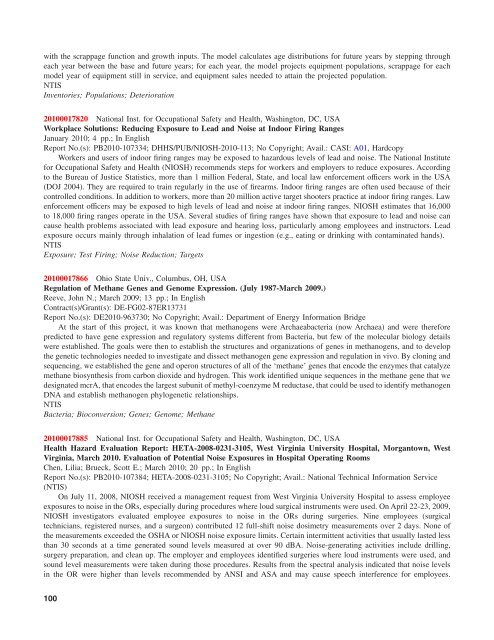NASA Scientific and Technical Aerospace Reports - The University ...
NASA Scientific and Technical Aerospace Reports - The University ...
NASA Scientific and Technical Aerospace Reports - The University ...
Create successful ePaper yourself
Turn your PDF publications into a flip-book with our unique Google optimized e-Paper software.
with the scrappage function <strong>and</strong> growth inputs. <strong>The</strong> model calculates age distributions for future years by stepping through<br />
each year between the base <strong>and</strong> future years; for each year, the model projects equipment populations, scrappage for each<br />
model year of equipment still in service, <strong>and</strong> equipment sales needed to attain the projected population.<br />
NTIS<br />
Inventories; Populations; Deterioration<br />
20100017820 National Inst. for Occupational Safety <strong>and</strong> Health, Washington, DC, USA<br />
Workplace Solutions: Reducing Exposure to Lead <strong>and</strong> Noise at Indoor Firing Ranges<br />
January 2010; 4 pp.; In English<br />
Report No.(s): PB2010-107334; DHHS/PUB/NIOSH-2010-113; No Copyright; Avail.: CASI: A01, Hardcopy<br />
Workers <strong>and</strong> users of indoor firing ranges may be exposed to hazardous levels of lead <strong>and</strong> noise. <strong>The</strong> National Institute<br />
for Occupational Safety <strong>and</strong> Health (NIOSH) recommends steps for workers <strong>and</strong> employers to reduce exposures. According<br />
to the Bureau of Justice Statistics, more than 1 million Federal, State, <strong>and</strong> local law enforcement officers work in the USA<br />
(DOJ 2004). <strong>The</strong>y are required to train regularly in the use of firearms. Indoor firing ranges are often used because of their<br />
controlled conditions. In addition to workers, more than 20 million active target shooters practice at indoor firing ranges. Law<br />
enforcement officers may be exposed to high levels of lead <strong>and</strong> noise at indoor firing ranges. NIOSH estimates that 16,000<br />
to 18,000 firing ranges operate in the USA. Several studies of firing ranges have shown that exposure to lead <strong>and</strong> noise can<br />
cause health problems associated with lead exposure <strong>and</strong> hearing loss, particularly among employees <strong>and</strong> instructors. Lead<br />
exposure occurs mainly through inhalation of lead fumes or ingestion (e.g., eating or drinking with contaminated h<strong>and</strong>s).<br />
NTIS<br />
Exposure; Test Firing; Noise Reduction; Targets<br />
20100017866 Ohio State Univ., Columbus, OH, USA<br />
Regulation of Methane Genes <strong>and</strong> Genome Expression. (July 1987-March 2009.)<br />
Reeve, John N.; March 2009; 13 pp.; In English<br />
Contract(s)/Grant(s): DE-FG02-87ER13731<br />
Report No.(s): DE2010-963730; No Copyright; Avail.: Department of Energy Information Bridge<br />
At the start of this project, it was known that methanogens were Archaeabacteria (now Archaea) <strong>and</strong> were therefore<br />
predicted to have gene expression <strong>and</strong> regulatory systems different from Bacteria, but few of the molecular biology details<br />
were established. <strong>The</strong> goals were then to establish the structures <strong>and</strong> organizations of genes in methanogens, <strong>and</strong> to develop<br />
the genetic technologies needed to investigate <strong>and</strong> dissect methanogen gene expression <strong>and</strong> regulation in vivo. By cloning <strong>and</strong><br />
sequencing, we established the gene <strong>and</strong> operon structures of all of the ‘methane’ genes that encode the enzymes that catalyze<br />
methane biosynthesis from carbon dioxide <strong>and</strong> hydrogen. This work identified unique sequences in the methane gene that we<br />
designated mcrA, that encodes the largest subunit of methyl-coenzyme M reductase, that could be used to identify methanogen<br />
DNA <strong>and</strong> establish methanogen phylogenetic relationships.<br />
NTIS<br />
Bacteria; Bioconversion; Genes; Genome; Methane<br />
20100017885 National Inst. for Occupational Safety <strong>and</strong> Health, Washington, DC, USA<br />
Health Hazard Evaluation Report: HETA-2008-0231-3105, West Virginia <strong>University</strong> Hospital, Morgantown, West<br />
Virginia, March 2010. Evaluation of Potential Noise Exposures in Hospital Operating Rooms<br />
Chen, Lilia; Brueck, Scott E.; March 2010; 20 pp.; In English<br />
Report No.(s): PB2010-107384; HETA-2008-0231-3105; No Copyright; Avail.: National <strong>Technical</strong> Information Service<br />
(NTIS)<br />
On July 11, 2008, NIOSH received a management request from West Virginia <strong>University</strong> Hospital to assess employee<br />
exposures to noise in the ORs, especially during procedures where loud surgical instruments were used. On April 22-23, 2009,<br />
NIOSH investigators evaluated employee exposures to noise in the ORs during surgeries. Nine employees (surgical<br />
technicians, registered nurses, <strong>and</strong> a surgeon) contributed 12 full-shift noise dosimetry measurements over 2 days. None of<br />
the measurements exceeded the OSHA or NIOSH noise exposure limits. Certain intermittent activities that usually lasted less<br />
than 30 seconds at a time generated sound levels measured at over 90 dBA. Noise-generating activities include drilling,<br />
surgery preparation, <strong>and</strong> clean up. <strong>The</strong> employer <strong>and</strong> employees identified surgeries where loud instruments were used, <strong>and</strong><br />
sound level measurements were taken during those procedures. Results from the spectral analysis indicated that noise levels<br />
in the OR were higher than levels recommended by ANSI <strong>and</strong> ASA <strong>and</strong> may cause speech interference for employees.<br />
100

















